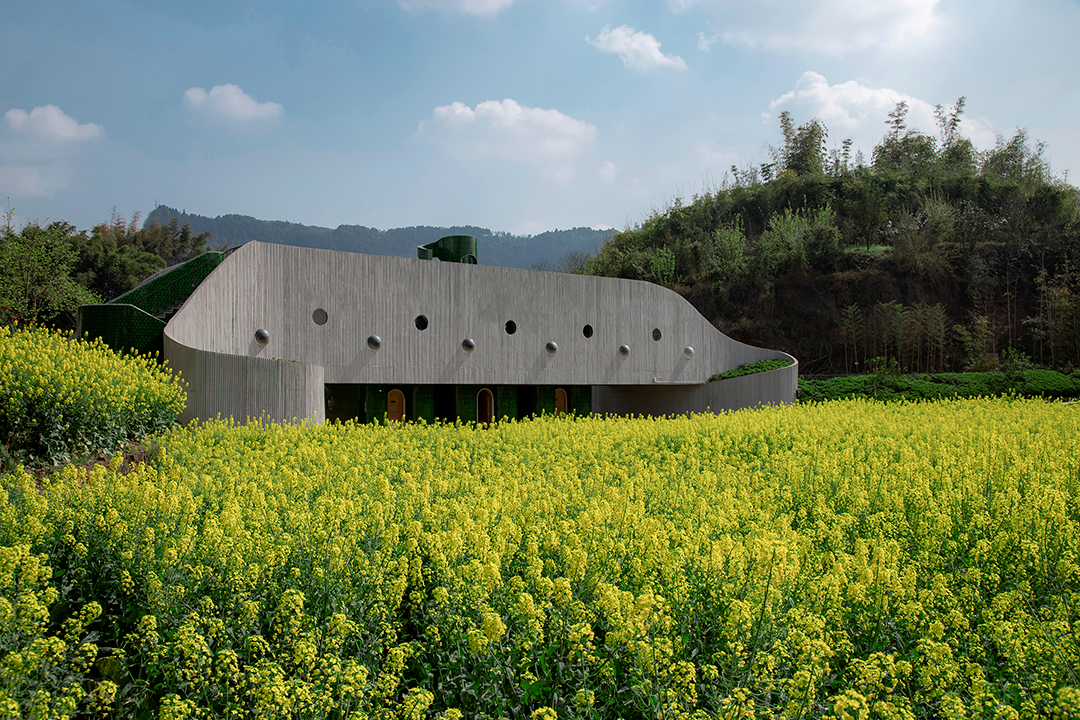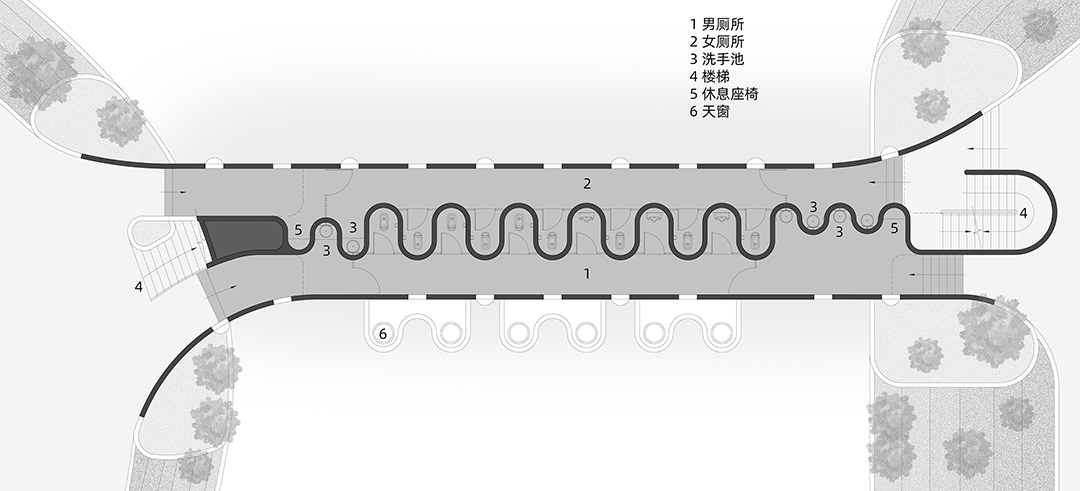
设计单位 锋茂建筑
项目地点 四川宜宾
建成时间 2022年11月
建筑面积 180平方米
本文文字由设计单位提供。
高桥村位于四川宜宾,“宜长兴”百里翠竹长廊旁,是一个藏在林徽因诗歌《十一月的小村》中的美丽川南小村庄。近几年高桥村以竹文化、竹产业为主题,发展成为一个以竹为特色的农旅融合乡村振兴示范村。
Gaoqiao Village is located in Yibin, Sichuan Province, next to the Yichangxing Hundred Mile Green Bamboo Corridor. It is a beautiful small village in southern Sichuan hidden in Lin Huiyin's poem "A Small Village in November". In recent years, with the theme of bamboo culture and bamboo industry, it has become a famous village for the integration of agriculture and tourism in rural revitalization with bamboo as its characteristic.
相比商业、文化或民宿等其他类型的建筑,公共厕所是在乡村振兴过程中容易被忽视一种公共配套设施,但其在解决农民生理需求的同时,还能与农作休息、农具储藏以及农业观光旅游等功能集合成农业配套综合体。因此,设计希望通过对当地生态科技的适当运用,将科技与农业生产进行融合。
Compared with other public buildings like commercial, cultural, or hotel, public toilet is a public supporting facility that is easily ignored in the process of rural revitalization. They integrate the physiological needs of farmers with functions such as agricultural rest, tool storage, and agricultural tourism to form an agricultural supporting complex. The design aims to integrate technology with agricultural production through the application of appropriate local ecological technologies.

项目位于村子入口区域的一片农田之中,设计需要将农民日常的生活作息与游客的功能设施进行融合。场地两侧道路形成夹角,呈合围之势,道路之间为农田。道路与农田之间大约有4米高差。设计从场地出发,以“连接+配套”为切入点,将“桥”和“厕”两个主题进行融合,既对道路系统进行了完善,也满足了农民以及游客的功能需求。
The project is located in the middle of farmland at the entrance of the village. The building needs to integrate the daily life of farmers with the functional facilities of tourists. The roads on both sides of the site form an angle to create encirclement, with farmland between the roads. There is a height difference of approximately 4 meters between the road and the farmland. The design starts from the site and takes "connection & supporting" as the starting point, integrating the two themes of "bridge" and "toilet". It not only improves the road system, but also meets the functional needs of local farmers and tourists.


整个建筑的形体以“永续生态循环”为理念,通过对结构墙体的立体折叠,构建空间三维自支撑结构体系,将两侧道路系统进行连接。建筑以一个独特的姿态与四周的农田融合在了一起。
The overall shape of the building is based on the concept of sustainable ecological cycle, and through the three-dimensional folding of structural walls, a three-dimensional self-supporting structural system is constructed to connect the road systems on both sides. The building integrates into the surrounding farmland with a unique posture.



桥上部的两侧分别为男、女卫生间,由于整个桥面宽度的限制,我们设计了一个连续折叠的墙面,将男、女厕所以折叠间隔的方式进行布置。在合理的桥面宽度内,项目既保证了桥两侧人行流线的联通,又满足了功能要求,同时在厕所内部形成了绿色瓷砖与竹编门有节奏地间隔的虚实效果。
On both sides of the upper part of the bridge are male and female toilets. Due to the width limitation, we have designed a continuous folding wall. The male and female toilets are arranged in a folding interval. Within a reasonable bridge deck width, it not only ensures the connection of pedestrian flow lines on both sides of the bridge, but also meets functional requirements. At the same time, a rhythmic virtual and real effect is formed inside the toilet.


建筑的底部设置为家庭卫生间、无障碍卫生间和农具储藏间,设计通过两侧楼梯使屋顶层以及厕所层三个不同标高形成联系。绿色瓷砖覆盖的连续墙面延展到建筑的屋顶平台,形成一些可游可憩的构筑物,并构成一个可以远眺的观景平台。
The lower level of the building is equipped with a family bathroom, an accessible bathroom and a storage room for agricultural tools. The roof level and toilet level are connected at three different elevations through stairs on both sides. The continuous wall surface of green tiles extends to the roof platform of the building, and is arranged as some structures that can be enjoyed for sightseeing, forming a viewing platform.


外侧墙面设置了两个标高的圆形舷窗——上侧平面圆窗为成年人提供采光和观景;下侧外凸的泡泡窗为儿童提供了一个可用于对外远望、嬉戏的有趣空间。整个建筑外侧是由当地工人完成的、粗砺的竹模混凝土墙面,内侧为光洁的本地生产绿色瓷砖,相互形成对比。建设过程中,项目通过运用当地材料以及与当地工人和竹编手艺人积极合作,以在地建造的方式,推动中国的乡村振兴。
Two levels of circular portholes are set on the outer wall surface: the upper flat circular window provides lighting and viewing for adults, and the lower convex bubble window provides children with an interesting space for external observation and play. The outer side of the entire building is made of rough bamboo formwork concrete walls completed by local workers, while the inner side is made of smooth locally produced green tiles, creating a contrast. During the construction process, the use of local materials and active cooperation with local workers and bamboo craftsman are utilized to promote rural revitalization in China through on-site construction.

设计图纸 ▽




完整项目信息
项目名称:桥-厕
建设地点:四川宜宾翠屏区李庄镇高桥村
建设单位:宜宾翠屏区李庄镇高桥村委会
设计单位:锋茂建筑
设计团队:王坚锋、Nico Willy Leferink、王荣
设计顾问:温钦皓
结构顾问及施工图设计:上海源规建筑结构设计事务所
设计时间:2021年2月
竣工时间:2022年11月
建筑面积:180平方米
摄影师:张元戎、李茂竹
本文由锋茂建筑授权有方发布。欢迎转发,禁止以有方编辑版本转载。
上一篇:“未完成”空间:DININGR:UM 媒体创意工作室 / 诰丰建筑
下一篇:Cobe联合团队,在芬兰埃斯波市中心打造木结构市政大楼